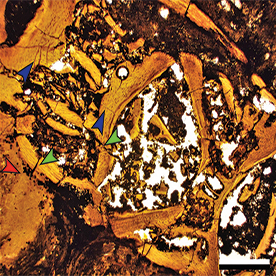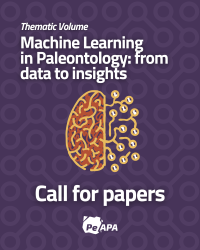BROMALITES FROM THE AMEGHINO (=NORDENSKJÖLD) FORMATION UPPER JURASSIC OF ANTARCTIC PENINSULA
DOI:
https://doi.org/10.5710/PEAPA.11.04.2023.446Keywords:
Coprolites, Actinopterygian remains, Macropredator vertebrates, West Antarctica, Longing GapAbstract
We present the study of the bromalites retrieved from the Upper Jurassic Ameghino (=Nordenskjöld) Formation at Longing Gap in the Antarctic Peninsula. The material was morphologically and chemically analyzed. We made a qualitative study and a taphonomic analysis of the specimens and tested paleobiological and paleoecological hypotheses. We conclude that the samples analyzed are coprolites and propose a new ichnotaxon, Antarctoscoprus longinensis ichnogen. and ichnosp. nov., characterized by being a small and flat coprolite differing from other ichnogenera by its composition, which consists mainly of actinopterygian remains (e.g., scales, vertebrae, skull bones, and teeth). Antarctoscoprus longinensis includes three morphotypes (i.e., circular, subcircular, and elongated) derived from an elongated three-dimensional original form by compactation. Based on the internal content, we infer the producers of the coprolites were carnivorous predators, putatively an ichthyophagous taxon. Due to the abundance of actinopterygians—mainly aspidorhynchids and ichthyodectids— and the size of the coprolites we propose macropredator fishes as the putative producers. The mainly undisrupted fish carcasses and coprolites allow us to conduct further studies that might lead to a better understanding of the ancient communities living in the Late Jurassic Sea that surrounded Antarctica.
References
Aceñolaza, F. G. (2012). Neogene coprolites (Upper Miocene-Lower Pliocene) of Entre Rios province, Northeastern Argentina. Scientia Interfluvius, 3(1), 41–53.
Arratia, G., Scasso, R., & Kiessling, W. (2004). Late Jurassic fishes from Longing Gap, Antarctic Peninsula. Journal of Vertebrate Paleontology, 24(1), 41–55. https://doi.org/10.1671/1952-4
Baker, R., Buckland, A., & Sheaves, M. (2013). Fish gut content analysis: robust measures of diet composition. Fish and Fisheries, 15(1), 170–177. https://doi.org/10.1111/faf.12026
Barrios-de Pedro, S. (2019). Bones of pycnodontiform fishes (Actinopterygii: Pycnodontiformes) in coprolites from the Barremian fossil site of Las Hoyas (Cuenca, Spain). Journal of Vertebrate Paleontology, 39(4), e1667814. https://doi.org/10.1080/02724634.2019.1667814
Barrios-de Pedro, S., & Buscalioni, A. D. (2018). Scrutinizing Barremian coprolite inclusions to record digestive strategies. Annales Societatis Geologorum Poloniae, 88(2), 203–221. https://doi.org/10.14241/asgp.2018.014
Barrios-de Pedro, S., Poyato-Ariza, F., Moratalla, J. J., & Buscalioni, A. D. (2018). Exceptional coprolite association from the Early Cretaceous continental Lagerstätte of Las Hoyas, Cuenca, Spain. PLoS ONE, 13(5), e0196982. https://doi.org/10.1371/journal.pone.0196982
Barrios-de Pedro, S., Chin, K., & Buscalioni, A. D. (2020). The late Barremian ecosystem of Las Hoyas sustained by fishes and shrimps as inferred from coprofabrics. Cretaceous Research, 110, 104409. https://doi.org/10.1016/j.cretres.2020.104409
Bigurrarena Ojeda, M. A., Gouiric-Cavalli, S., Perez, L. M., & Reguero, M. (2017). Preliminary study of the coprolites from the Ameghino Formation (Late Jurassic) of the Antarctic Peninsula. IX Congreso Latinoamericano de Ciencia Antártica. Visiones sobre Ciencia Antártica (pp. 90-93). Punta Arenas.
Bradley, W. H. (1946). Coprolites from the Bridger Formation of Wyoming: Their composition and microorganisms. American Journal of Science, 244(3), 215–239. https://doi.org/10.2475/ajs.244.3.215
Buckland, W. (1829). On the discovery of corpolites, or fossil faeces, in the Lias at Lyme Regis, and other formations. Transactions of the Geological Society of London, 2–3, 223–236.
Campos, L., Fernández, M. S., Herrera, Y., Talevi, M., Concheyro, A., Gouiric- Cavalli,S., O'Gorman J. P., Santillana, S. N., Acosta-Burlaille, L., Moly, J. J., & Reguero, M. A. (2021). Bridging the southern gap: First definitive evidence of Late Jurassic ichthyosaurs from Antarctica and their dispersion routes. Journal of South American Earth Sciences, 109, 103259. https://doi.org/10.1016/j.jsames.2021.103259
Chimento, N. R., & Rey, L. (2008). Hallazgo de una feca fósil en el Pleistoceno Superior-Holoceno Inferior del partido de General Guido, provincia de Buenos Aires, Argentina. Revista del Museo Argentino de Ciencias Naturales, n. s., 10(2), 239–254.
Chin, K. (2002). Analyses of coprolites produced by carnivorous vertebrates. Paleontological Society Papers, 8, 43–50. https://doi.org/10.1017/S1089332600001042
Cueillie, M., Green, E., Duffin, C. J., Hilderbrandt, C., & Benton, J. (2020). Fish and crab coprolites from the latest Triassic of the UK: From Buckland to the Mesozoic Marine Revolution. Proceedings of the Geologists' Association, 131(6), 699–721. https://doi.org/10.1016/j.pgeola.2020.07.011
Dietrich, W. O. (1951). Koprolithen aus dem Pleistozän Ostafrikas. Neues Jahrbuch für Geologie und Paläontologie, Monatshefte, 10, 310–314.
Doyle, P., Whitham, & A. G. (1991). Paleoenvironments of the Nordenskjold Formation: An Antarctic Late Jurassic–Early Cretaceous black shale–tuff sequence. In R.V. Tyson, & T.H. Pearson (Eds.), Modern and Ancient Continental Shelf Anoxia (pp. 397–414). Geological Society of London, Special Publication 58.
Ebert, M., Kölbl-Ebert, M., & Lane, J. A. (2015). Fauna and predator-prey relationships of Ettling, an actinopterygian fish-dominated Konservat-Lagerstätte from the Late Jurassic of Southern Germany. PLoS ONE, 10(1), e0116140. https://doi.org/10.1371/journal.pone.0116140
Elliot, D.H. (1988). Tectonic setting and evolution of the James Ross Basin, northern Antarctic Peninsula. Geological Society of North America Memoires, 169, 541–555.
Farquharson, G. W. (1982). Late mesozoic sedimentation in the northern Antarctic Peninsula and its relationship to the southern Andes. Journal of the Geological Society of London, 139, 721–727. https://doi.org/10.1144/gsjgs.139.6.072
Foster, J. R., Hunt, A. H. & Kirkland, J. I. 2022. Significance of a small regurgitalite containing lissamphibian bones, from the Morrison Formation (Upper Jurassic), whitin a diverse plant locality deposit in southeastern Utah, USA. Palaios, 37, 433–442.
Gouiric-Cavalli, S., Acosta Burllaile, L., Iglesias, A., Moly, J. J., O´Gorman, J. P., Reguero, M., Santillana, S., Talevi, M., Vieytes, C., Bigurrarena Ojeda, M. A., & Lusky, J. (2017). Late Mesozoic marine Antarctic fishes: future perspectives based on the newly collections recovered in the Ameghino and López de Bertodano Formations. Research & Knowledge, 3(1), 16–61.
Gouiric-Cavalli, S., Rasia, L. L., Marquez, G. J., Rosato V. G., Scasso R. A., Reguero, M. A. (2019). First pachycormiform (Actinopterygii, Pachycormiformes) remains from the Late Jurassic of the Antarctic Peninsula and remarks on bone alteration by recent bioeroders. Journal of Vertebrate Paleontology, 38(5), e1524384. https://doi.org/10.1080/02724634.2018.1524384
Gouiric-Cavalli, S., & Arratia, G. (2022). A new †Pachycormiformes (Actinopterygii) from the Upper Jurassic of Gondwana sheds light on the evolutionary history of the group. Journal of Systematics Palaeontology, 19(21), 1517–1550. https://doi.org/10.1080/14772019.2022.2049382
Gouiric-Cavalli, S., Cariglino, B., Iglesias, A., & Reguero, M. (2022). Isolated and fragmentary fossil findings: clues for fossil fish diversity and keys for further research. SCAR Open Science Conference. https://virtual.scar2022.org/eposter-detailes.php?token=MTc5
Garassino, A. & Donovan, D. T. (2000). A new family of coleoids from the Lower Jurassic of Osteno, northern Italy. Palaeontology, 43(6), 1019–1038.
Häntzschel, W. (1975). Trace fossils and problematica. In C. Teichert (Ed.), Treatise on invertebrate paleontology, Part W, Miscellanea, Supplement 1 (p. W1-W269). Geological Society and America, and Lawrence, University of Kansas Press, 2nd ed.
Häntzschel, W., El-Baz, F., & Amstutz, G. C. (1968). Coprolites, an Annotated Bibliography. Memoir of the Geological Society of America, 108, 1–132. https://doi.org/10.1130/MEM108
Hauff, B. (1921). Untersuchung der Fossilfundstatten in Posidonienschiefer des oberen Lias Württemberg. Palaeontographica, 64, 1–42
Hoffmann, R., Stevens, K., Keupp, H., Simonsen, S., & Schweigert, G. (2019). Regurgitalites – a window into the trophic ecology of fossil cephalopods. Journal of the Geological Society, 177(1), 82—102. https://doi.org/10.1144/jgs2019-117
Hunt, A. P. (1992). Late Pennsylvanian coprolites from the Kinney rick Quarry, central New Mexico, with notes on the classification and utility of coprolites. New Mexico Bureau of Mines and Mineral Resources Bulletin, 138, 221—229.
Hunt, A. P., & Lucas S. G. (2012a). Classification of vertebrate coprolites and related traces fossils. New Mexico Museum of Natural History and Science Bulletin, 57, 137—146.
Hunt, A. P., & Lucas, S. G. (2012b). Descriptive terminology of coprolites and feces. New Mexico Museum of Natural History and Science Bulletin, 57, 153—160.
Hunt, A. P., & Lucas, S. G. (2014). Jurassic vertebrate bromalites of the western United States in the context of the global record. Volumina Jurassica, 12(2), 151–158. https://doi.org/10.5604/17313708 .1130139
Hunt A. P., & Lucas S. G. (2020). Coprolites. Encyclopedia of Geology (Second Edition), Trace Fossils (3), 532–544. https://doi.org/10.1016/B978-0-12-409548-9.12477-7
Hunt A. P., & Lucas S. G. (2021). The ichnology of vertebrate consumption: Dentalites, Gastroliths and bromalites. New Mexico Museum of Natural History and Science Bulletin, 87, 1—216.
Hunt, A. P., Lucas, S. G., & Lockley, M. G. (1998). Taxonomy and stratigraphic and fades significance of vertebrate coprolites of the Upper Triassic Chinle Group, Western United States. Ichnos, 5(3): 225–234. https://doi.org/10.1080/10420949809386419
Hunt, A. P., Lucas S. G., Spielmann, J. A., & Lerner, A. J. (2007). A review of vertebrate coprolites of the Triassic with descriptions of new Mesozoic ichnotaxa. The Global Triassic. New Mexico Museum of Natural History and Science Bulletin, 41, 88–107.
Hunt, A. P., Lucas, S. G., & Spielmann, J. A. (2012a). The bromalite collection at the National Museum of Natural History (Smithsonian Institution), with descriptions of new ichnotaxa and notes on other significant coprolite collections. New Mexico Museum of Natural History and Science Bulletin, 57, 105–114.
Hunt, A. P., Lucas, S. G., & Spielmann, J. A. (2012b). New coprolite ichnotaxa from the Buckland collection at the Oxford University Museum of Natural History. New Mexico Museum of Natural History and Science Bulletin, 57, 115–124.
Hunt, A. P., Lucas, S. G., Milán, J., & Spielmann, J. A. (2012c). Vertebrate coprolite studies: status and prospectus. Vertebrate Coprolites. New Mexico Museum of Natural History and Science Bulletin, 57, 5–24.
Kapur, V. V., Kumar, K., Morthekai, P., & Chaddha, A. S. (2019). Palaeodiet of Miocene Producer(s) and Depositional Environment(s): Inferences from the First Evidence on Microcoprolites from India. Acta Geologica Sinica, 94(5), 1574–1590. https://doi.org/10.1111/1755-6724.14293
Kiessling, W., & Scasso, R. A. (1996). Ecological perspectives of Late Jurassic radiolarian faunas from the Antactic Peninsula. In A. C. Riccardi (Ed.), Advances in Jurassic Research 27 (pp. 317–326). Transtec, Zürich. https://doi.org/10.4028/www.scientific.net/RC.27
Kiessling, W., Scasso, R., Zeiss, A., Riccardi, A., & Medina, F. (1999). Combined radiolarian-ammonite stratigraphy for the Late Jurassic of the Antarctic Peninsula: implications for radiolarian stratigraphy. Geodiversitas, 21(4), 687–713.
Kietzmann, D. A., & Palma, R. M. (2011). Microcoprolitos de crustáceos del Jurásico Superior de la Cuenca Neuquina. XVIII Congreso Geológico Argentino, S13 Rocas carbonáticas y evaporíticas. Neuquén.
Kietzmann, D. A., & Scasso, R. A. (2020). Jurassic to Cretaceous (upper Kimmeridgian–?lower Berriasian) calcispheres from high palaeolatitudes on the Antarctic Peninsula: Local stratigraphic significance and correlations across Southern Gondwana margin and the Tethyan realm. Palaeogeography, Palaeoecology, Palaeoecology, 537, 109419. https://doi.org/10.1016/j.palaeo.2019.109419
Kietzmann, D. A., Cuitiño, J. A., Medina, R. A., & Scasso, R. A. (2009). Análisis de cadenas de Markov en series de Fourier en una secuencia hemipelágica del Jurásico Superior de la Península Antártica. Latin American Journal of Sedimentology and Basin Analysis, 16(1), 45–56.
Kogan, I., & Licht, M. (2013). A Belonostomus tenuirostris (Actinopterygii: Aspidorhynchidae) from the Late Jurassic of Kelheim (southern Germany) preserved with its last meal. Paläontologische Zeitschrift, 87, 543–548. https://doi.org/10.1007/s12542-013-0179-z
Krause, J. M., & Piña, C. I. (2012). Reptilian coprolites in the Eocene of central Patagonia, Argentina. Journal of Palaeontology, 86(3), 527–538. https://doi.org/10.1666/11-075.1
Li, L., He, Q., Ma, Y., Wang, X. & Peng, X. (2015). Dynamics of microbial community in a mesophilic anaerobic digester treating food waste: Relationship between community structure and process stability. Bioresource Technology, 189, 113–120. https://doi.org/10.1016/j.biortech.2015.04.015
Luo, M., Hu, S., Benton, M. J., & Shi, G. R. (2017). Taphonomy and palaeobiology of early Middle Triassic coprolites from the Luoping biota, southwest China: Implications for reconstruction of fossil food webs. Palaeogeography, Palaeoclimatology, Palaeoecology, 474, 232–246. https://doi.org/10.1016/j.palaeo.2016.06.001
Maisey, J. G. (1994). Predator-prey relationships and trophic level reconstruction in a fossil fish community. Environmental Biology of Fishes, 40, 1–22. https://doi.org/10.1007/BF00002179
Mancuso, A. C., Benavente, C. A., Previtera, E., Arucci, A. B., & Irmis, R. B. (2017). Carnivore coprolites from the lower Carnian (Upper Triassic) Chañares Formation, northwestern Argentina. Palaeogeography, Palaeoclimatology, Palaeoecology, 489, 15–28. https://doi.org/10.1016/j.palaeo.2017.07.032
Martill, D. M. (1985), The preservation of marine vertebrates in the Lower Oxford Clay (Jurassic) of central England: Philosophical Transactions, Royal Society London, Series B, 311, 155–165.
Medina, F. A., & Ramos, A. M. (1981). Geología de las inmediaciones del Refugio Ameghino (64°26’S -58° 59’O). Tierra de San Martín, Península Antártica. VIII Congreso Geológico Argentino (actas2, pp. 871–882), San Luis.
Medina, F. A., & Ramos, A. (1983). Geología de las inmediaciones del Refugio Ameghino (64°26’S -58° 59’O). Tierra de San Martín, Península Antártica. Contribución del Instituto Antártico Argentino, 229, 1–14.
Milán, J., Hunt, A. P., Adolfssen, J. S., Rasmussen, B, W., & Bjerager, M. (2015). First record of a vertebrate coprolite from the Upper Cretaceous (Maastrichtian) chalk of stevns klint, Denmark. New Mexico Museum of Natural History and Science Bulletin, 67, 227–230.
O'Gorman, J. P., Gouiric-Cavalli, S., Scasso, R. A., Reguero, M., Moly, J. J., & Acosta-Burlaille, L. (2018). A Late Jurassic plesiosaur in Antarctica: Evidence of the dispersion of marine fauna through the Trans-Erythraean Seaway?. Comptes Rendus Palevol, 17(3), 158–165. https://doi.org/10.1016/j.crpv.2017.10.005
Qvarnström, M., Niedźwiedzki, G., & Žigaitė, Z. (2016). Vertebrate coprolites (fossil faeces): An underexplored Konservat-Lagerstätte. Earth-Science Reviews, 162, 44–57. https://doi.org/10.1016/j.earscirev.2016.08.014
Rakshit, N., Bhat, M. S., Mukherjee, D., & Ray, S. (2018). First record of Mesozoic scroll coprolites: classification, characteristics, elemental composition and probable producers. Palaeontology, 62(3), 451–471. https://doi.org/10.1111/pala.12409
Retallack, G. J., & Krull, E. S. (1997). Permian coprolites from Graphite Peak, Antarctica. Antarctic Journal of the United States, 32(5), 7–9.
Richter, M., & Thomson, M. R. A. (1989). The first Aspidorhynchidae (Pisces: Teleostei) from Antarctica. Antarctic Science, 1(1), 57–64. https://doi.org/10.1017/S0954102089000106
Richter, G., & Baszio, S. (2001). Traces of a limnic food web in the Eocene Lake Messel – a preliminary report based on fish coprolite analyses. Palaeogeography, Palaeoclimatology, Palaeoecology, 166(3–4), 345–368. https://doi.org/10.1016/S0031-0182(00)00218-2
Richter, G., & Wedmann, S. (2005). Ecology of the Eocene Lake Messel revealed by analysis of small fish coprolites and sediments from a drilling core. Palaeogeography, Palaeoclimatology, Palaeoecology, 223(1–2), 147–161. https://doi.org/10.1016/j.palaeo.2005.04.002
Scasso, R. A. (2001). High-frequency explosive volcanic eruptions in a Late Jurassic volcanic arc: The Ameghino Formation, Antartic Peninsula. Journal of Sedimentary Research, 71(1), 101–106. https://doi.org/10.1306/032100710101
Scasso, R. A., & Kiessling, W. (2001). Diagenesis of Upper Jurassic concretion from the Antarctic Peninsula. Journal of Sedimentary Research, 71(1), 88–100. https://doi.org/10.1306/032800710088
Schweigert, G., & Dietl, G. (2012). Vertebrate coprolites from the Nusplingen lithographic limestone (Upper Jurassic, SW Germany). New Mexico Museum of Natural History and Science Bulletin, 57, 215–220.
Silva, R. R., Ferigolo, J., Bajdek, P., & Piñeiro, G. (2017). The feeding habits of Mesosauridae. Frontiers in Earth Science, 5, 23. https://doi.org/10.3389/feart.2017.00023
Thulborn, R. A. (1991). Morphology, preservation and palaeobiological significance of dinosaur coprolites. Palaeogeography, Palaeoclimatology, Palaeoecology, 83, 341–366.
Vallon, L. H. (2012). Digestichnia (Vialov, 1972) – an almost forgotten ethological class for trace fossils. New Mexico Museum of Natural History and Science Bulletin, 57, 131–135.
Viohl, G. (1990). Piscivorous fishes of the Solnhofen Limestone. In A. J. Boucot (Ed.), Evolutionary paleobiology of behavior and coevolution (pp. 287–303). Elsevier, New York.
Whitham, A. G. (1993). Facies and depositional processes in an Upper Jurassic to Lower Cretaceous pelagic sedimentary sequence, Antartica. Sedimentolgy, 40(2), 331–349. https://doi.org/10.1111/j.1365-3091.1993.tb01767.x
Whitham, A. G., & Doyle, P. (1989). Stratigraphy of the Upper Jurassic– Lower Cretaceous Nordenskjöld Formation of Graham Land, Antarctica. Journal of South American Earth Sciences, 2(4), 371–384. https://doi.org/10.1016/0895-9811(89)90015-1

Additional Files
Published
Issue
Section
License
Copyright (c) 2023 Mauricio A. Bigurrarena Ojeda, Soledad Gouiric-Cavalli, Leandro M. Perez, Marcelo A. Reguero

This work is licensed under a Creative Commons Attribution-NoDerivatives 4.0 International License.
Authors retain copyright and grant the journal right of first publication with the work simultaneously licensed under a Atribución/Reconocimiento 4.0 Internacional that allows others to share the work with an acknowledgement of the work's authorship and initial publication in this journal.
















